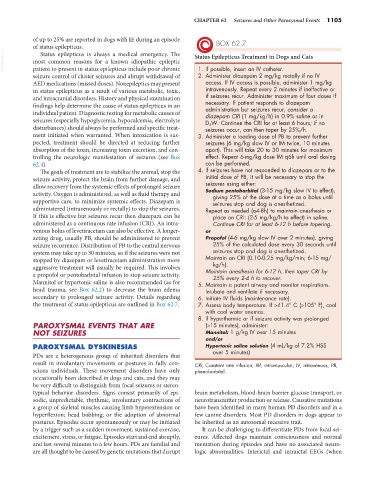Page 1133 - Small Animal Internal Medicine, 6th Edition
P. 1133
CHAPTER 62 Seizures and Other Paroxysmal Events 1105
of up to 25% are reported in dogs with IE during an episode
of status epilepticus. BOX 62.7
VetBooks.ir most common reasons for a known idiopathic epileptic Status Epilepticus Treatment in Dogs and Cats
Status epilepticus is always a medical emergency. The
patient to present in status epilepticus include poor chronic
2. Administer diazepam 2 mg/kg rectally if no IV
seizure control of cluster seizures and abrupt withdrawal of 1. If possible, insert an IV catheter.
AED medications (missed doses). Nonepileptics may present access. If IV access is possible, administer 1 mg/kg
in status epilepticus as a result of various metabolic, toxic, intravenously. Repeat every 2 minutes if ineffective or
and intracranial disorders. History and physical examination if seizures recur. Administer maximum of four doses if
findings help determine the cause of status epilepticus in an necessary. If patient responds to diazepam
administration but seizures recur, consider a
individual patient. Diagnostic testing for metabolic causes of diazepam CRI (1 mg/kg/h) in 0.9% saline or in
seizures (especially hypoglycemia, hypocalcemia, electrolyte D 5 W. Continue the CRI for at least 6 hours; if no
disturbances) should always be performed and specific treat- seizures occur, can then taper by 25%/h.
ment initiated when warranted. When intoxication is sus- 3. Administer a loading dose of PB to prevent further
pected, treatment should be directed at reducing further seizures (6 mg/kg slow IV or IM twice, 10 minutes
absorption of the toxin, increasing toxin excretion, and con- apart). This will take 20 to 30 minutes for maximum
trolling the neurologic manifestation of seizures (see Box effect. Repeat 6-mg/kg dose IM q6h until oral dosing
62.4). can be performed.
The goals of treatment are to stabilize the animal, stop the 4. If seizures have not responded to diazepam or to the
seizure activity, protect the brain from further damage, and initial dose of PB, it will be necessary to stop the
allow recovery from the systemic effects of prolonged seizure seizures using either:
Sodium pentobarbital (3-15 mg/kg slow IV to effect),
activity. Oxygen is administered, as well as fluid therapy and giving 25% of the dose at a time as a bolus until
supportive care, to minimize systemic effects. Diazepam is seizures stop and dog is anesthetized.
administered (intravenously or rectally) to stop the seizures. Repeat as needed (q4-8h) to maintain anesthesia or
If this is effective but seizures recur then diazepam can be place on CRI: (2-5 mg/kg/h to effect) in saline.
administered as a continuous rate infusion (CRI). An intra- Continue CRI for at least 6-12 h before tapering.
venous bolus of levetiracetam can also be effective. A longer- or
acting drug, usually PB, should be administered to prevent Propofol (4-6 mg/kg slow IV over 2 minutes), giving
seizure recurrence. Distribution of PB to the central nervous 25% of the calculated dose every 30 seconds until
system may take up to 30 minutes, so if the seizures were not seizures stop and dog is anesthetized.
stopped by diazepam or levetiracetam administration more Maintain on CRI (0.10-0.25 mg/kg/min; 6-15 mg/
kg/h).
aggressive treatment will usually be required. This involves Maintain anesthesia for 6-12 h, then taper CRI by
a propofol or pentobarbital infusion to stop seizure activity. 25% every 2-4 h to recover.
Mannitol or hypertonic saline is also recommended (as for 5. Maintain a patent airway and monitor respirations.
head trauma, see Box 62.2) to decrease the brain edema Intubate and ventilate if necessary.
secondary to prolonged seizure activity. Details regarding 6. Initiate IV fluids (maintenance rate).
the treatment of status epilepticus are outlined in Box 62.7. 7. Assess body temperature. If >41.4° C (>105° F), cool
with cool water enemas.
8. If hyperthermic or if seizure activity was prolonged
PAROXYSMAL EVENTS THAT ARE (>15 minutes), administer:
NOT SEIZURES Mannitol: 1 g/kg IV over 15 minutes
and/or
PAROXYSMAL DYSKINESIAS Hypertonic saline solution (4 mL/kg of 7.2% HSS
PDs are a heterogenous group of inherited disorders that over 5 minutes)
result in involuntary movements or postures in fully con- CRI, Constant rate infusion; IM, intramuscular; IV, intravenous; PB,
scious individuals. These movement disorders have only phenobarbital.
occasionally been described in dogs and cats, and they may
be very difficult to distinguish from focal seizures or stereo-
typical behavior disorders. Signs consist primarily of epi- brain metabolism, blood-brain barrier glucose transport, or
sodic, unpredictable, rhythmic, involuntary contractions of neurotransmitter production or release. Causative mutations
a group of skeletal muscles causing limb hyperextension or have been identified in many human PD disorders and in a
hyperflexion; head bobbing; or the adoption of abnormal few canine disorders. Most PD disorders in dogs appear to
postures. Episodes occur spontaneously or may be initiated be inherited as an autosomal recessive trait.
by a trigger such as a sudden movement, sustained exercise, It can be challenging to differentiate PDs from focal sei-
excitement, stress, or fatigue. Episodes start and end abruptly, zures. Affected dogs maintain consciousness and normal
and last several minutes to a few hours. PDs are familial and mentation during episodes and have no associated neuro-
are all thought to be caused by genetic mutations that disrupt logic abnormalities. Interictal and intraictal EEGs (when

